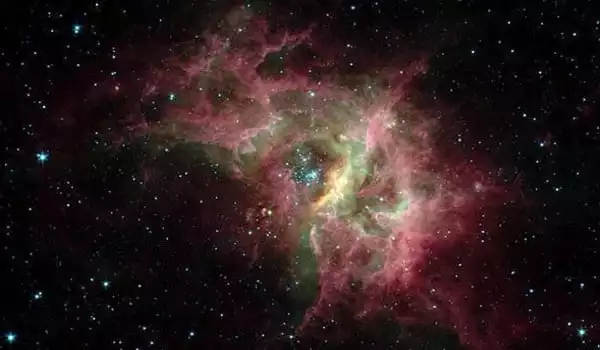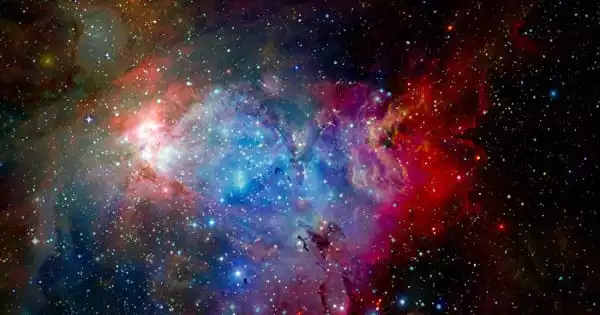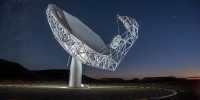A recent discovery sheds light on how fluorine, an element found in our bones and teeth as fluoride, is formed in the Universe. A team of astronomers detected this element in a galaxy so far away that its light took over 12 billion years to reach us using the Atacama Large Millimeter/submillimeter Array (ALMA), in which the European Southern Observatory (ESO) is a partner. This is the first time fluorine has been discovered in a star-forming galaxy so far away.
“We all know about fluorine because the toothpaste we use every day contains it in the form of fluoride,” says Maximilien Franco of the University of Hertfordshire in the United Kingdom, who led the new study, which was published today in the journal Nature Astronomy. Fluorine, like most elements around us, is created inside stars, but we didn’t know how it was created until now. “We didn’t even know what kind of stars produced the vast majority of fluorine in the Universe!”
Franco and his colleagues discovered fluorine (as hydrogen fluoride) in the large clouds of gas in the distant galaxy NGP-190387, which we see as it was when the Universe was only 1.4 billion years old, or about 10% of its current age. Because stars expel the elements formed in their cores as they die, this discovery implies that the stars that created fluorine must have lived and died quickly.
Fluorine, like most elements around us, is created inside stars, but we didn’t know how it was created until now. We didn’t even know what kind of stars produced the vast majority of fluorine in the Universe!
Maximilien Franco
The team believes that the most likely fluorine production sites are Wolf-Rayet stars, which are very massive stars that live for only a few million years, a blink of an eye in the history of the Universe. They are required to explain the amounts of hydrogen fluoride discovered by the team, according to them. Wolf-Rayet stars had previously been proposed as possible sources of cosmic fluorine, but astronomers did not know how important they were in producing this element in the early Universe until now.
“We’ve shown that Wolf-Rayet stars, which are among the most massive stars known and can explode violently as they near the end of their lives, help us maintain good dental health!” Franco jokes.
Aside from these stars, other hypotheses for how fluorine is produced and expelled have been proposed in the past. Pulsations of giant evolved stars with masses up to a few times that of our Sun, known as asymptotic giant branch stars, are one example. However, the researchers believe that these scenarios, some of which take billions of years to play out, may not fully explain the amount of fluorine in NGP-190387.

“It only took tens or hundreds of millions of years for this galaxy to reach fluorine levels comparable to those found in stars in the Milky Way, which is 13.5 billion years old. This was a completely unexpected outcome”, Chiaki Kobayashi, professor at the University of Hertfordshire, agrees. “Our finding adds a completely new constraint to the origin of fluorine, which has been studied for over two decades.”
The discovery of fluorine in NGP-190387 is one of the first beyond the Milky Way and its neighboring galaxies. This element has previously been discovered in distant quasars, which are bright objects powered by supermassive black holes at the center of some galaxies. This element, however, had never been observed in a star-forming galaxy so early in the Universe’s history.
The team’s discovery of fluorine was a coincidental finding made possible by the use of space and ground-based observatories. NGP-190387, discovered with the European Space Agency’s Herschel Space Observatory and later observed with Chile’s ALMA, is unusually bright for its distance. The ALMA data confirmed that NGP-190387’s exceptional luminosity was caused in part by another known massive galaxy located very close to the line of sight between NGP-190387 and the Earth. This massive galaxy amplified the light observed by Franco and his colleagues, allowing them to detect the faint radiation emitted by the fluorine in NGP-190387 billions of years ago.
Future studies of NGP-190387 with the Extremely Large Telescope (ELT) – ESO’s new flagship project, currently under construction in Chile and set to begin operations later this decade – may reveal new details about this galaxy. “ALMA is sensitive to radiation emitted by cold interstellar gas and dust,” says Chentao Yang, a Chilean ESO Fellow. “We will be able to observe NGP-190387 through the direct light of stars with the ELT, gaining crucial information on the stellar content of this galaxy.”
















